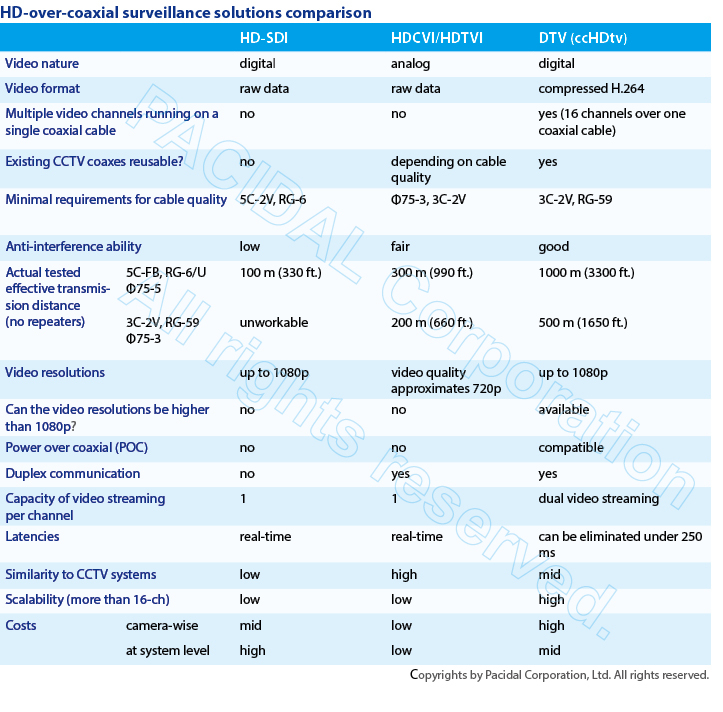
HD-over-coaxial surveillance solutions
The comparison among the HD-over-coaxial solutions, including HD-SDI, HDCVI/HDTVI, and DTV surveillance, is listed in the table below.

When it comes to how to select among HD solutions over coaxial cables, including HD-SDI, HDCVI/TVI, and DTV surveillance, several questions should be taken into consideration:
What are the specifications required?
How would you like the deployment be?
How many budgets do you have?
What are the specifications required?
The common concerns include video resolutions and how power is supplied. To pursue full HD video quality with genuine 1080p resolution, HD-SDI and DTV are good choices, both of which are digital solutions per se. Other upgrade solutions, such as HDCVI or HDTVI cameras, which are analog solutions, also claimed they have specifications similar to 1080p in the digital world. However, it is uncertain whether the real resolutions can be elevated up to that level or not. It is commonly believed that HDCVI and HDTVI can do video quality approximate to 720p resolution. For resolutions higher than that, how the real image quality looks might be a question awaiting answer. In addition, how camera power is going to be supplied in a security system is another key specification to ponder. Do you want camera power to be supplied separately from cables carrying signals? Or do you prefer providing power using signal cables simultaneously, namely, the function of Power Over Coax (POC)? If POC is preferred, DTV surveillance is the only solution among all to fulfill your need. But if POC isn’t a requirement, you may consider all the solutions over coaxes.
How would you like the deployment be?
Retaining the original coaxial cables or not?
In cases as CCTV upgrades, relevant questions might be: do you want to retain the original coaxial cables in a CCTV system, or do you prefer to deploy new cables? If you tend to preserve previous coaxial cables, HDCVI/TVI and DTV are suitable choices because in all three systems, videos can be transmitted on 3C-2V or RG-59 cables, the most common coaxial cable types used for current CCTV systems. In such cases, HD-SDI might not be a proper solution since it requires coaxial cables of higher quality, such as 5C-2V, a more expensive type of coax cables and less common used in current CCTV systems.
Transmission distance
The range of deployment is another important issue to think about. For transmission range greater than 100 meters (328 ft.), it would be better to consider the other two solutions, HDCVI/TVI and DTV, rather than HD-SDI. In this way, you save costs from buying additional repeaters or high quality coaxial cables. But in fact, how to decide among HDCVI, HDTVI, or DTV cameras will depend on your targets on maximal transmission distance in a security system. For applications that need transmission range longer than 300 meters, DTV surveillance shows the most robust capability for long distance transmission. The image quality won’t be attenuated after long distance transmission. If the target transmission distance falls between 100 meters to 300 meters, either HDCVI/TVI or DTV surveillance can make it.
Anti-interference ability
Though HDCVI, HDTVI, and DTV surveillance are HD solutions that can carry videos through 3C-2V or RG-59 cables, it should be noted that, in terms of anti-interference capability on coaxes, their degrees of tolerance differ. For cases aiming to retain and reuse existing coaxial cables in a CCTV system, DTV surveillance is much more insensitive to the status quo of cable quality compared to either HDCVI or HDTVI. Specifically, as long as a coaxial cable can still carry analog video signals at current status, it can be preserved and reused in the new DTV system. Video signal transmission can be transmitted smoothly, regardless of original signal quality of the CCTV system. Composite videos in HDCVI or HDTVI solutions, however, are more subject to the influence of current cable quality conditions in comparison with DTV surveillance. In other words, the more noise or blurring instances found due to cable quality condition of the original CCTV videos, the more likely the image quality of a newly installed HDCVI or HDTVI system might be deteriorated. Therefore, if one considers retaining coaxial cables in an original CCTV system for system upgrades, the degree of anti-interference tolerance of each upgrade solution should definitely be taken into consideration as well.
Star topology or daisy-chain?
If you’d like to connect different cameras using a single coaxial cable, DTV surveillance is the only solution that supports this daisy-chain topology. If not, all solutions support star topology.
How many budgets do you have?
Budgets are definitely one of the most important factors on making purchase decisions. HDCVI and HDTVI are quite competitive in terms of costs, since their framework is almost the same as CCTV structures, suitable for users with tight budgets constraints. DTV surveillance is appropriate for advanced or professional applications where customers have more flexible range on budgets.
Citation Statement: Anyone who wants to use the entire or partial text/graphs of this web article should explicitly cite the full URL of this original page. http://www.pacidal.com/technology_HD-over-coaxial-comparison.html